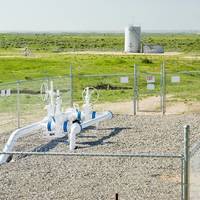U.S. Crude Oil Exports: When 'Less is More'

Longer sailing distances cushion fall in US crude oil exportsTon mile demand generated by US crude oil exports has fallen by 9.7% in the first two months of 2021 compared with the start of 2020. The fall could however have been much worse; In volume terms, seaborne crude oil exports have fallen by 18.8%, to 20.9m tonnes, a 4.8m tonnes decline compared with last year, according to data from the US Census Bureau.While seaborne crude oil exports to all regions have fallen, those to Asia are among the least affected, down just 1.0%, or equivalent to one Aframax load (101,088 tonnes).
Enterprise Offers Crude Shipments From Gulf Coast to Cushing

Enterprise Products Partners LP said it would offer spot shipments of crude on an existing pipeline from the U.S. Gulf coast to Cushing, Oklahoma, the delivery point for benchmark U.S. crude futures, as demand to store oil inland surges.The move marks a sharp reversal from recent pipeline projects that were all built connecting inland markets to the Gulf Coast as U.S. crude exports climbed to record highs after Washington lifted a ban in late 2015.However, the coronavirus pandemic has crushed global oil demand and dented U.S.
European Refiners Leave Oil Cargoes On Water

A growing number of oil tankers across Europe have been unable to unload their cargo over the past month as refining demand crashes, turning them into de facto floating storage, according to shipping data and trading sources.European refineries have had to cut runs after measures put in place to contain the coronavirus outbreak crushed fuel demand.More than 25 tankers with roughly 18 million barrels onboard were anchored near European ports, with most them already there for over a week as of Thursday…
Oil Storage at Sea Approaching Record Levels

Oil traders are storing as much as 80 million barrels of oil on tankers at sea, with further ships being sought as land storage sites fill up fast due to a global glut of stocks, shipping industry sources say.Traders rushed for storage after global oil demand collapsed by a third due to the coronavirus outbreak, and as top producers Saudi Arabia and Russia have refused to curb output so far, creating what is believed to be the biggest oil glut in history.The last time floating storage reached similar levels was in 2009…
Brent's Fall Creates Steepest Contango in 11 Years

The discount on front-month Brent crude oil futures to later contracts increased to an 11 year high on Thursday, as the coronavirus pandemic continued to cause an unprecedented slump in global demand. The spread on the May to November contracts had widened to as much as minus $10.31 per barrel at 1004 GMT, a level not seen since January 2009. The so-called contango market structure implies traders expect oil prices to be higher in the future, in this case when the virus pandemic has hopefully passed, leading them to store crude onshore or in some cases at sea.
Libya says Probe of Seized Tanker to Start After Quarantine
Libya's internationally recognized government will start an investigation into a tanker over alleged sanctions-breaking after a period of quarantine ends in two weeks, the coast guard commander who seized the vessel said on Wednesday.The coast guard at Misrata seized the Gulf Petroleum 4 three days ago, Rida Issa said, after the National Oil Corporation (NOC) said the tanker had broken an arms embargo and other international agreements by offloading jet fuel in Benghazi.Benghazi is the seat of a parallel administration in the east whose Libyan National Army (LNA) has been trying for a year to capture the capital Tripoli, where the internationally…
Shell in Talks to Book Tankers for Crude Floating Storage

Royal Dutch Shell is in discussions to charter at least three supertankers to store around 6 million barrels of crude oil at sea, shipping sources said on Wednesday.Shell has provisionally booked the vessels, known as very large crude carriers (VLCCs), for storage options for at least three months, the sources said, adding that the fixtures were still to be concluded.A Shell spokeswoman declined to comment.If fully fixed, these would be the first tankers to be used for floating…
Oil Prices Climb on Hopes of Deeper OPEC+ Production Cuts

Oil prices edged higher on Thursday as investors focused on the possibility of deeper supply cuts from the world's biggest producers, whilst largely shrugging off reports which cut demand forecasts after the coronavirus outbreak in China, the biggest oil importer.Brent crude was up 32 cents, or 0.6%, at $56.11 a barrel by 10:52 a.m. ET (1552 GMT), while U.S. West Texas Intermediate (WTI) was up 14 cents at $51.31 a barrel.The energy complex was led higher by U.S. gasoline futures…
Castleton Closes Shell Shale Deal
Houston-based Castleton Resources said that its subsidiary Castleton Commodities International LLC (CCI) has closed on the acquisition of the East Texas and North Louisiana Haynesville Shale assets of BG US Production Company LLC, a subsidiary of Royal Dutch Shell plc. Pro forma for the acquisition, Castleton Resources will hold approximately 222,400 net acres in the region and produce approximately 334 MMcfe/d (net). Castleton Resources is owned by CCI and Tokyo Gas America Ltd., a wholly owned subsidiary of Tokyo Gas Co., Ltd. Concurrent with the transaction, Tokyo Gas America Ltd. will increase its interest in Castleton Resources from 30% to approximately 46%.
EIA, IEA Grossly Overestimating US Shale: ESAI
ESAI Energy, an oil & energy data provider, believes both the US Energy Information Administration (EIA) and the International Energy Agency (IEA) are overly optimistic in their November projections of US crude oil production in 2020, according to the company’s latest North America Watch.ESAI Energy sees a deceleration in growth to about 650,000 b/d next year, in contrast to the EIA and IEA forecasts of 1.0 million b/d and 900,000 b/d, respectively.ESAI points to declining capital expenditures by many shale producers in response to investor pressure to spend within cash flow, a service sector that is idling equipment and laying off workers…
US Shale Sector Performs Well
U.S. shale operators are on track to grow 2019 oil production by around 16% over 2018 thanks to impressive operational execution so far this year.The third quarter earnings season revealed that shale companies increased their oil production by about two percent, all while cutting the midpoint guidance for yearly drilling and completions expenses, according to Rystad Energy.The energy research and consulting firm headquartered in Norway said that U.S. shale operators will continue expanding in the fourth quarter, growing oil production by at least 1.3 percent on a quarterly basis.“The actual results so far this year reaffirm our optimistic expectations for the remainder of the year.
US Crude Exports Expected to Double by 2022
The U.S. could see its crude oil exports nearly double by 2022, according to energy research firm Rystad Energy. US crude exports could grow from current levels of 2.9 million barrels per day (bpd) to nearly 6 million bpd by 2022.With US production expected to increase by 1.2 million bpd year-over-year (y/y) in 2020, and with domestic refineries already maxing out capacity to absorb shale growth, Rystad Energy expects exports to balloon and reach 4.7 million bpd by the end of 2020 and nearly 6 million bpd by the end of 2022.“Crude exports will grow on the back of new infrastructure coming online in Corpus Christi, Texas, and as international…
Flaring Runs Higher in Permian
Flaring and venting in the Permian Basin has stabilized in the range of 600 million to 650 million cubic feet per day (MMcfd), according to Rystad Energy’s preliminary data for the third quarter of 2019.Venting is gas release without combustion, whereas flaring is the burning of excess capacity. In New Mexico, vented and flared gas is reported separately and our research indicates that, on average, 5% to 15% of total flared and vented production stream is vented.In particular, reported data from recent quarters shows a significant decrease in the frequency of venting relative to flaring, with only 8% of waste gas being vented. In the case of Texas…
Frac Water Demand to Increase 30% by 2022
Frac water demand is expected to increase 30% by 2022, with 53% of that increase taking place in the Permian Basin, said Rystad Energy in its recently released “Water Management Report”.The increase in water demand is mostly driven by increases in forecasted completions activity, and the continued trend towards longer laterals.Rystad Energy expects frac water demand across the US to hit 4.9 billion barrels in 2019, with 2.28 billion barrels taking place in the Permian Basin.Rystad Energy normally defines spare capacity as a country’s underutilized capacity, including any current outages.
U.S. Drillers Cut Rigs Again: Baker Hughes

U.S. energy firms this week reduced the number of oil rigs operating for a seventh week in a row as producers follow through on plans to cut spending on new drilling this year.Drillers cut 3 oil rigs in the week to Oct. 4, bringing the total count down to 710, the lowest since May 2017, General Electric Co's Baker Hughes energy services firm said in its closely followed report on Friday.In the same week a year ago, there were 861 active rigs.The oil rig count, an early indicator of future output…
US Shale is Not Doomed, Says Rystad Energy
Though bankruptcies among U.S. onshore exploration and production (E&P) companies are on the increase during these days, Rystad Energy doesn’t believe this indicates doom for the shale industry.“In a nutshell, we do not believe the recent bankruptcies that have beset a number of shale players are indicative of an industry-wide epidemic,” says Alisa Lukash, a senior analyst on Rystad Energy’s North American Shale team.During the next seven years, the top 40 US shale oil producers are expected to spend about $100 billion on debt instalments and interest unless further debt refinancing is applied.These drillers, which accounted for nearly half of US shale crude production in 2018…
US Shale to Peak at 14.5Mbpd in 2030
US shale supply will peak at approximately 14.5 million barrels per day (bpd) around 2030, said the energy research and business intelligence company Rystad Energy.In the past decade, crude oil coming from shale patches such as the Permian in the US has grown from a negligible contributor to an upstream behemoth, reshaping the industry and the oil market.US Light Tight Oil (LTO) represented less than 1% of global oil supply just nine years ago. Today, US LTO represents close to 10% of total global oil supply, a percentage which is expected to continue its ascent going forward. But by how much? That is the million-dollar question.Different agencies and knowledge houses have responded to this with varying degrees of positivity and skepticism.
Gas Flaring Dips in the Permian
Natural gas flaring in the Permian dropped in the first quarter of 2019 – the first drop in one-and-a-half years, according to energy research firm Rystad Energy.Rystad Energy has been closely monitoring the level of natural gas flaring in the Permian since 2017. "Our previous quarterly estimate suggested that basin-wide gas flaring reached record-high levels of beyond 660 million cubic feet per day (MMcfd) in the fourth quarter of 2018 and the first quarter of 2019," it said.However, just released final data for the first quarter of 2019 have led to a downward revision of our previous flaring estimate by 7%, to 613 MMcfd.“This is the first time that has happened over the past 1.5 years.
Rates Slowdown in Permian Basin
Though the Permian Basin still dominates US land drilling, the pace of growth in this region has slowed significantly.Older tight oil wells decline by 20% per year without material intervention, according to Rystad Energy.Contrary to common belief, the Permian Basin systematically offers the lowest oil decline rates, along with the Bakken Shale.In turn, the Eagle Ford and DJ basins exhibit steeper decline rates throughout the first eight years of production across most vintages.Rystad Energy has examined all horizontal oil-producing wells in the Bakken, Eagle Ford, Permian and DJ Basins, turned-in-line between 2011 and 2017 with at least 24 months of reported production.The resulting sample includes 146,158 annualized production data points from 46,188 wells.
US Shale Operators Achieves Positive Cash Flow
In a remarkable turnaround, the second quarter of 2019 is the first three-month period on record when US shale operators achieved positive cash flow from operations after accounting for capital expenditures, according to Rystad Energy.Rystad Energy has studied the financial performance of 40 dedicated US shale oil companies, focusing on cash flow from operating activities (CFO). This is the cash that is available to expand the business (via capital expenditure, or capex), reduce debt, or return to shareholders.In the second quarter of 2019, 35% of operators in the peer group balanced their spending with operational cash flow, and reported an accumulated $110 million surplus in CFO versus capex.“That is an industry first,” says Rystad Energy senior analyst Alisa Lukash.
Permian Fracking Sets New Records
Hydraulic fracturing operations in the Permian shattered old records in June. The prolific shale basin in Texas and parts of New Mexico in the US has reached new heights in terms of the number of fracked wells – both on a daily basis and in terms of absolute monthly wells. Rystad Energy estimates there were as many as 18 wells fracked per day across the entire Permian Basin, or almost 550 wells during the month of June. Previously, fracking in the Permian peaked at approximately 520 wells fracked in August 2018, while the peak daily rate was reached in February earlier this year.“The Midland platform has undoubtedly been the driver of this upwards trend with consistent month-over-month increases…
Cheniere Working on Sabine Pass Trains 3, 4

Cheniere Energy Inc said on Monday it is conducting previously scheduled turnarounds on Trains 3 and 4 at the Sabine Pass liquefied natural gas (LNG) export terminal in Louisiana as part of its maintenance plan for the facility.The company did not say when the units would likely return to service but noted "a good general guide for timing" was work on Sabine Trains 1 and 2 earlier this year that lasted about three weeks.Cheniere has five liquefaction trains operating at Sabine…
Permian Basin is Booming!
The increased output from the Permian Basin, located in West Texas and Southeastern New Mexico, has been the biggest contributor to the growth of super majors.A handful of industry insiders have recently speculated that the Permian may be on its way out, noting that well productivity in the Permian is declining. In fact, the truth is quite the opposite, said Rystad Energy.E&P operators active in the Permian Basin, spanning parts of Texas and New Mexico in the US, have been facing a growing number of concerns about the ability of the industry to achieve additional improvements in well productivity.Some market participants argue that the average well performance in the Permian is already declining…






